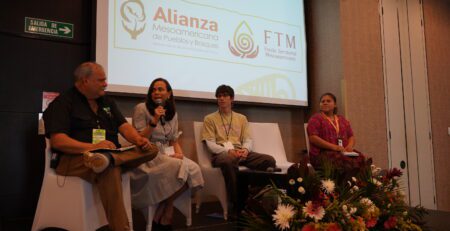19/02/24. San José, Costa Rica.
San José was the host of an international meeting where more than 80 representatives of Indigenous Peoples and local community (IPLC) organizations from Mesoamerica, international cooperation, donors, and philanthropists exchanged ideas to find ways to channel direct resources to Indigenous and local communities from Mexico to Panama.
This “Dialogue on the Impact of Direct Territorial Financing to Indigenous Peoples and Local Communities in Mesoamerica,” organized by the Mesoamerican Territorial Fund (FTM) and the Mesoamerican Alliance of Peoples and Forests (AMPB), was an open space where all represented sectors exchanged proposals, concerns, and lessons learned around a common goal: the protection of forests from multiple threats such as climate change, extensive livestock farming, criminalization, mining, and other forms of irrational exploitation of natural resources.
According to Leonides Cunanpia, Chief of the Emberá Wounaan Territory in Panama, “For Indigenous Peoples, from Mexico to Panama, our goal is the protection of forests and rivers, but most of the funds approved for nature protection in Indigenous communities do not reach us; they get stuck in administrative procedures. We need to improve direct communication between donors and Indigenous organizations and leaders.”
Other voices echoed this call for resources to be allocated to organizations within the territories through more horizontal processes, where Indigenous and local communities are heard and actively participate in decision-making, as they are the ones who best understand the realities and environmental threats in their territories.
Alondra Cerdas, a Cabécar Indigenous person and President of the Bribri-Cabécar Indigenous Network of Costa Rica, noted that “It is also important that funds reach Indigenous women-led organizations directly, because we can manage and administer resources correctly and transparently. We have the capabilities and work every day in forest protection and food security, but it has been a struggle to be visible and considered as women.”
The event showcased successful examples of direct fund management by Indigenous organizations and local communities. “Not even 10% of the funds reach Indigenous Peoples; the myth that we cannot directly manage resources is over. There are many Indigenous and local organizations, and we have created the Shandia Platform, which brings together four direct financing funds in different regions of the world: Indonesia, Congo, Brazil, and Mesoamerica, where we have the Mesoamerican Territorial Fund,” stated Juan Carlos Jintiach, an Indigenous person from the Ecuadorian Amazon and Executive Secretary of the Global Alliance of Territorial Communities. Jintiach also noted that many Indigenous organizations already have strategic work plans and are leading data collection on global financing and its real impact.
“These funds not only arise simultaneously but do so in a participatory manner and in collaboration among organizations, with a spirit of solidarity rather than competition,” mentioned Kevin Currey from the Ford Foundation in one of the panels.
In Mesoamerica, Indigenous Peoples and local communities, who make up the Mesoamerican Alliance of Peoples and Forests, have created the Mesoamerican Territorial Fund (FTM) as a tool for direct financing. “The Fund not only aims to channel resources to these communities but also to strengthen or create local capacities so that the investment is sustainable over time. It does not mean that we want blank checks, without accountability and without responsible management, but it does mean that bureaucracy and transaction costs are reduced,” stated María Pía Hernández, Manager of the Mesoamerican Territorial Fund.
From the cooperation side, the interest and need to work more directly with territorial organizations was highlighted. According to Andrea Johnson from the Climate and Land Use Alliance (CLUA), “These exchanges are very important because they generate more trust relationships, allow us to understand each other, and exchange experiences that come from very different perspectives. We must break the traditional scheme of a one-way relationship between donors and organizations, where money flows from top to bottom because a donor brings money, but communities and their organizations provide everything else, so it should be an alliance.”
The event achieved an open exchange on a development agenda with common points and future joint work strategies. “It is a success to have brought the cooperation that is in the region face to face with the leadership of Indigenous and local community organizations and to be able to show them that there are other direct financing models like the Mesoamerican Territorial Fund,” stated Levi Sucre, a Bribri Indigenous person from Costa Rica and General Director of the Mesoamerican Alliance of Peoples and Forests. Sucre concluded that they now hope these discussions will contribute to changes in policies, procedures, and the focus of cooperation in the region for Indigenous Peoples and local communities.

